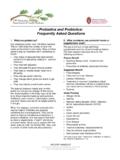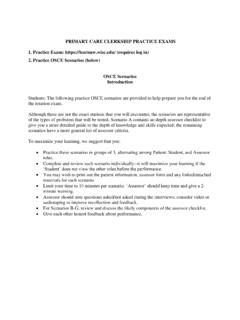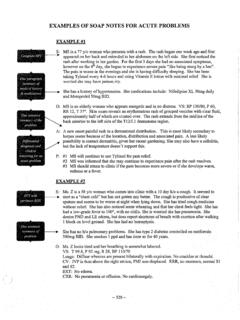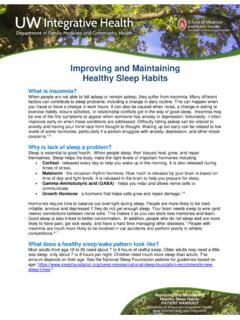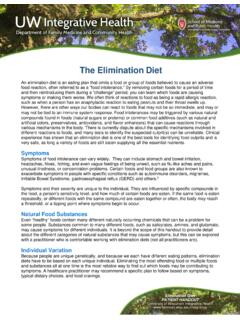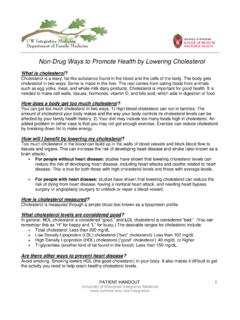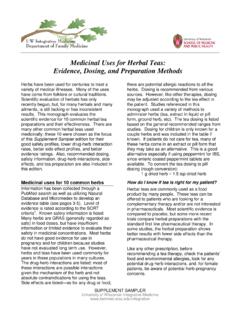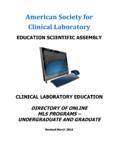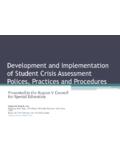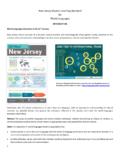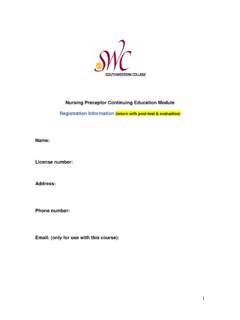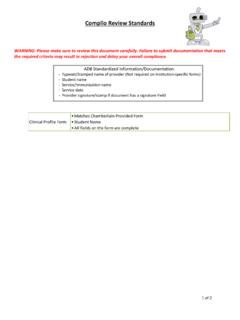Transcription of Effective Clinical Education: Strategies for Teaching ...
1 Author Affiliation: UW Health Augusta Family Medicine Clinic, Augusta, Author: William E. Cayley Jr, MD, MDiv, UW Health Augusta Family Medicine Clinic, 207 W Lincoln St, Augusta, WI 54722; phone ; fax ; e-mail RESEARCH178 WMJ AUGUST Furthermore, research has demonstrated that physicians who pre-cept medical students typically spend a significant amount of extra time teach-ing, consequently seeing fewer patients and losing study of Clinical preceptors found that 3 factors commonly influence which patients are selected by precep-tors for Teaching encounters with medi-cal students: the potential influence of Teaching on the doctor-patient relation-ship, the educational value for the stu-dent, and considerations of time and The impact of Teaching on the doc-tor-patient relationship can be influ-enced by whether a patient is estab-lished and returning for follow-up, and perhaps more likely to want only a known and trusted physician, or new and perhaps more likely to provide an opportunity for the learner to have a fresh start on a Clinical problem.
2 The educational potential in patient visits may be related to the opportu-nity for the learner to have a fresh start on a new Clinical problem or diagnosis, or the opportunity for the learner to shadow in multiple visits to maximize exposure to patients and diagnoses. Time for and efficiency of Teaching is influ-enced by patient volume for the Clinical day and the balance between visits for follow-up of established problems vs visits for new or undiagnosed models or Strategies for Clinical Teaching have been described in the medical education literature. This article reviews 4 specific Clinical Teaching Strategies and the evidence for their impact on educational outcomes or office efficiency. Literature for this review was selected based on the results of a Pub Med search on the terms medical student and precepting, review of references in retrieved articles, and the author s personal files.
3 INTRODUCTIONE ducating medical students and residents in the office set-ting presents the simultaneous challenges of providing qual-ity medical care, maintaining efficiency, and incorporating meaningful education for learners. A recent literature review identified several common barriers that often impede Effective Clinical Teaching , including time constraints, inadequate insti-tutional financial support, lack of access to educational spe-cialists, and lack of access to appropriate educational space and ABSTRACTP roblem: Educating medical students and residents in the office presents the challenges of providing quality medical care, maintaining efficiency, and incorporating meaningful educa-tion for learners. Numerous Teaching Strategies to address these challenges have been described in the medical educational literature, but only a few Teaching Strategies have been evaluated for their impact on education and office practice.
4 Methods: Literature on the impact of office-based Teaching Strategies on educational out-comes and on office efficiency was selected from a Pub Med search, from review of refer-ences in retrieved articles, and from the author s personal files. Results: Two Teaching Strategies , one-minute preceptor (OMP) and SNAPPS, have been shown to improve educational processes and outcomes. Two additional Strategies , Aunt Minnie pattern recognition and activated demonstration, show promise but have not been fully evaluated. None of these Strategies has been shown to improve office efficiency. Conclusions: OMP and SNAPPS are Strategies that can be used in office precepting to improve educational processes and outcomes, while pattern recognition and activated demonstration show promise but need further assessment. Additional areas of research also are suggested. William E. Cayley Jr, MD, MDivEffective Clinical Education: Strategies for Teaching Medical Students and Residents in the OfficeCME available.
5 See page 203 for more 110 NO. 4179teaching encounters found that after participation in a set of three 90-minute faculty development seminars on the OMP model, faculty preceptors improved in the specificity of their feedback to Learner-Led EducationThe SNAPPS strategy was developed based on cognitive learning and reflective practice theory. This approach empha-sizes active learning and casts the precepting encounter as a learner-led experience. The SNAPPS acronym derives from the 6 steps of the process (Table 2). First, the student is asked to Summerize, generally in 3 minutes or less, the relevant history and physical findings. Second, the student is asked to Narrow the differential diagnosis or possible interventions to the 2 or 3 most relevant and likely possibilities. Commitment to an initial decision on the part of the student, prior to preceptor input, is a key part of this Teaching strategy.
6 Third, the learner should Analyze the differential by comparing and contrasting the pos-sible explanations. This allows the learner to verbalize thought processes. Fourth, the learner is asked to Probe the preceptor by asking about uncertainties, difficulties, or other approaches. This allows the preceptor insight into the learner s thought pro-cess and knowledge base, and teaches the student to see the pre-ceptor as a knowledge resource. Fifth, to Plan management of the patient, the learner initiates a discussion with the preceptor by attempting either a brief management plan or suggesting spe-cific interventions and then further refining these with precep-tor input. Lastly, the learner is asked to Select a case-related issue for self-directed learning and reading, with preceptor input as needed to help focus the question or select learning The 1 evaluation of SNAPPS that has been published com-pared preceptors trained in SNAPPS to preceptors given no specific educational instructions or just general instruction on feedback.
7 This study found that students working with SNAPPS-trained preceptors were more concise in their summa- One-Minute Precepting Education Using the 5 Microskills The one-minute preceptor (OMP) strategy, first described in the early 1990s, recommends 5 key steps or microskills for an Effective Teaching encounter (Table 1).4 First, getting a com-mitment, with questions such as What do you want to do? or If I weren t here, what would you do for the patient? is designed to encourage the learner s processing and synthesis of information obtained from the patient. Second, probing for supporting evidence with questions such as What factors did you consider in making that decision? or Were there other options you considered and discarded? is meant to help the preceptor understand the learner s fund of knowledge, analytic processes, and areas for further learning.
8 Third, Teaching gen-eral rules applicable to the case at hand, with a mini-lecture or suggested reading, is recommended to help the learner understand application of general medical reasoning and prin-ciples to individual cases. The fourth and fifth steps, reinforc-ing what was done right and correcting mistakes, involve providing descriptive, case-specific and behavior-focused feed-back to the a study comparing the OMP model with traditional models of ambulatory Teaching , 116 preceptors (primarily representing internal or family medicine) in 7 different faculty development programs watched videotaped Teaching encoun-ters of both OMP and traditional precepting. Those preceptors watching the OMP encounters were equally or better able to diagnose the patient s medical problem compared to preceptors who watched encounters using a traditional Teaching model.
9 Preceptors watching videotapes of the OMP model also rated students abilities higher on history taking and physical exami-nation, presentations, Clinical reasoning, and fund of knowledge. Preceptors watching tapes of OMP precepting also rated them-selves as more confident in evaluating students The same study also found that preceptors using the OMP model tended to provide more emphasis on disease-specific Teaching and focused more on higher-order thinking rather than on gen-eral disease A second study by the same investigators, in which 164 third- and fourth-year medical students viewed traditional or OMP Teaching encounters, found students rated OMP more Effective than traditional a study of residents with inpatient Teaching responsibili-ties, 28 residents who received a 1-hour lunchtime training ses-sion on OMP were compared with 29 control residents.
10 The residents trained in OMP were rated more highly afterward by their students on measures of asking for a commitment, providing feedback, and motivating me to do outside read-ing. However, there was no difference between the 2 groups in students ratings of their overall Teaching effectiveness. 8 A separate investigation using quantitative analysis of audiotaped Table 1. One-Minute Precepting (OMP)41. Get a commitment2. Probe for supporting evidence 3. Teach general rules4. Reinforce what was done right 5. Correct mistakesTable 2. SNAPPS101. Summarize relevant history and physical findings2. Narrow the differential: Likely? Relevant?3. Analyze the differential4. Probe the preceptor5. Plan patient management6. Select a case-related learning issue180 WMJ AUGUST 2011and Clinical data interpretation found that pattern recognition improved more quickly than data interpretation across all 4 years of medical While none of these studies specifi-cally assessed the proposed Aunt Minnie model of precepting described above, they do suggest a role for pattern recognition in medical education, which may bear further Demonstration Teaching a SkillWhile knowledge and analytic thinking processes can be taught either in the examination room or separately in a precepting encounter, hands-on skills involving physical examination or procedural interventions require the preceptors presence in the patient room, demonstration, supervision, and feedback.
